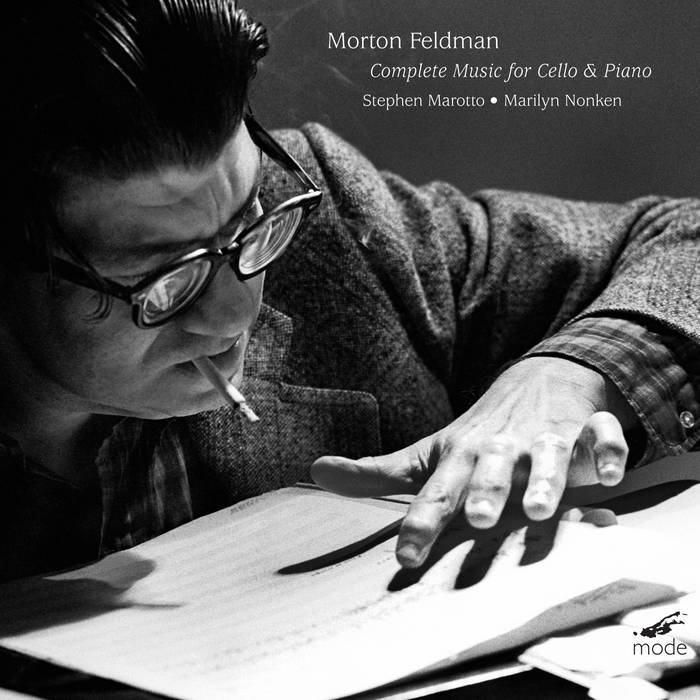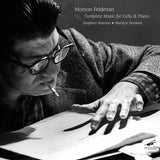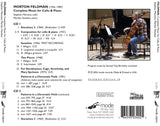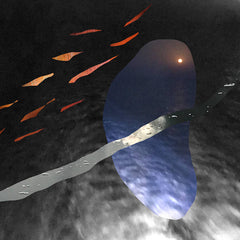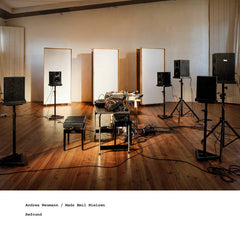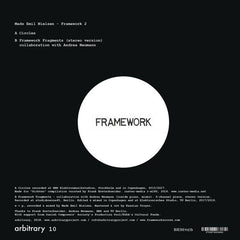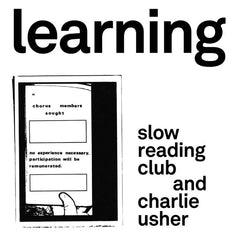Morton Feldman // Feldman Edition 14: Complete Music for Cello & Piano 2xCD
- Availability:
アメリカの作曲家Morton Feldman(1926-1987年)が、2024年3月に同国NYのコンテンポラリーレーベルModeからリリースした2枚組CDです。
彼が35年間で制作したチェロとピアノのための作品を未発表曲含め24曲全て収録。ライナーノート付属。
以下、Samuel Clay Birmaherによる解説です。
"このリリースでは、フェルドマンが作曲したチェロとピアノのための作品を、未発表作品や初録音を含めてすべて収録している。
これらの作品を合わせると、フェルドマンの音楽の物語が見えてくる。フェルドマンが学生時代に自分の声を探していたときから、晩年に新しい扉を開くまでの35年間、つまり彼の生涯の半分以上にわたる作品である。
このアルバムは、図形楽譜の柔軟性が何をもたらすかを聴く機会を与える『デュレーションズ2』(1960年)の2つのリアリゼーションで締めくくられている。
『ソナチネ』(1946年)は、最も初期の作品で、初録音。フェルドマンはベーラ・バルトークの影響を受け、楽器の演奏の現実を十分に理解することなく、彼が愛するチェロの音のために作曲した。その結果生まれたソロ・パートは素朴なヴィルトゥオーゾ的で、しばしば演奏不可能ですらある。この録音では、スティーヴン・マロットは可能な限り楽譜に忠実で、フェルドマンが心の耳で聴いたものを実現することを目指している。
1948年まで、フェルドマンは作曲家シュテファン・ヴォルプに個人的に数年間師事していた。その年に発表された未発表の《2つの小品》は、論理によってではなく、慎重に構えられた身振りによって、揺れ動く音楽をつなぎとめている。この作品や他の初期の作品に見られる感情的なドラマは、やがてフェルドマンの音楽から消えていくことになるが、「形」という考え方は、何よりもフェルドマンの生涯に残るものであった。
1950年、フェルドマンはジョン・ケージと出会い、ニューヨークのアヴァンギャルドの世界へと導かれた。未発表のコンパクトな「チェロとピアノのためのコンポジション」(1951年)は、突如として発表されたが、そのミニマルな素材とぼやけた音の記憶の中に、すでに彼の最後の作品のDNAが含まれている。
「シュトックハウゼン、ケージ、ストラヴィンスキー、そしてメアリー・スプリンソンのために」(1972年)は、フェルドマンが当時制作していた主要な作品群から切り離された、儚い未発表作品である。同じ和音を2つの異なる方法で表現している。
1時間29分近くある "Patterns in a Chromatic Field"(1981)は、フェルドマンの後期の長時間の作品であり、おそらくここに収録された作品の中で最もよく知られている。"
レーベルその他作品はこちら /// Click here to see more Mode releases available at Tobira.
Tracklist:
1. Durations 2 (1960) [Realization 1] 04:09
2. Composition for cello & piano (1951) I. 00:29
3. Composition for cello & piano (1951) II. 00:30
4. Composition for cello & piano (1951) III. 00:21
5. Composition for cello & piano (1951) IV. 00:28
6. Composition for cello & piano (1951) V. 00:26
7. Composition for cello & piano (1951) VI. 00:26
8. Composition for cello & piano (1951) VII. 00:24
9. Composition for cello & piano (1951) VIII. 01:31
10. Sonatina (1946) I. Allegro 03:35
11. Sonatina (1946) II. Larghetto cantabile e tranquillo 03:51
12. Sonatina (1946) III. Allegro grazioso 02:09
13. Two Pieces (1948) I. Allegro 00:34
14. Two Pieces (1948) II. Intermezzo 01:09
15. For Stockhausen, Cage, Stravinsky, and Mary Sprinson (1972) 00:46
16. Patterns in a Chromatic Field (1981) mm. 1-387, page 1 14:19
17. mm. 388-558 page 20 09:56
18. mm 559-792, page 27 14:16
19. mm. 793-864, page 35 13:20
20. mm. 865-1045, page 46 08:13
21. mm. 1046-1166, page 52 13:06
22. mm. 1167-1426, page 64 07:49
23. mm. 1427-end page 69 07:46
24. Durations 2 (1960) [Realization 2] 03:52
Stephen Marotto, cello
Marilyn Nonken, piano
Liner notes by Samuel Clay Birmaher :
"This release brings together ALL of Morton Feldman’s compositions for cello and piano, including unpublished works and a first recording.
Together, these works tell the story of Feldman’s music. They span 35 years — over half his lifetime — from when he was searching for his voice as a student to when he was opening new doors in the last years of his life.
The album is bookended by two realizations the graphic score “Durations 2” (1960), giving an opportunity to hear what the flexibility of graphic notation can bring.
The “Sonatina” (1946) is earliest work here, and a first recording. Displaying the influence of Béla Bartók, Feldman wrote for the cello sound he loved without fully understanding the realities of playing the instrument. The resulting solo part is naively virtuosic and often even impossible to play. For this recording, Stephen Marotto keeps as close as possible to the written score, aiming to fulfill what Feldman heard in his mind’s ear.
By 1948, Feldman had been studying privately with the composer Stefan Wolpe for several years. The unpublished “Two Pieces,” of that year is a fluctuating music held together not by logic, but through its carefully poised gestures — what Wolpe called “shape.” While the emotional drama of this and other early works would soon disappear from Feldman’s music, it was above all the idea of “shape” that remained with him for the rest of his life.
In 1950, Feldman met John Cage, who shepherded him into the world of the New York avant-garde. The unpublished, compact, “Composition for cello and piano” (1951) is a sudden breakthrough, yet it already contains the DNA of his very last works in its minimal material and blurred memories of sounds.
“For Stockhausen, Cage, Stravinsky, and Mary Sprinson” (1972) is an ephemeral, unpublished piece, a shard of music broken off from the main body of work Feldman was producing at the time. It consists of just two musical moments separated by silence — the same chord expressed in two different ways.
At almost 1 hour 29 minutes, “Patterns in a Chromatic Field” (1981) is of Feldman’s late, long duration period of works and it perhaps the best known of the works recorded here. "
artist : Morton Feldman
label : mode
アメリカの作曲家Morton Feldman(1926-1987年)が、2024年3月に同国NYのコンテンポラリーレーベルModeからリリースした2枚組CDです。
彼が35年間で制作したチェロとピアノのための作品を未発表曲含め24曲全て収録。ライナーノート付属。
以下、Samuel Clay Birmaherによる解説です。
"このリリースでは、フェルドマンが作曲したチェロとピアノのための作品を、未発表作品や初録音を含めてすべて収録している。
これらの作品を合わせると、フェルドマンの音楽の物語が見えてくる。フェルドマンが学生時代に自分の声を探していたときから、晩年に新しい扉を開くまでの35年間、つまり彼の生涯の半分以上にわたる作品である。
このアルバムは、図形楽譜の柔軟性が何をもたらすかを聴く機会を与える『デュレーションズ2』(1960年)の2つのリアリゼーションで締めくくられている。
『ソナチネ』(1946年)は、最も初期の作品で、初録音。フェルドマンはベーラ・バルトークの影響を受け、楽器の演奏の現実を十分に理解することなく、彼が愛するチェロの音のために作曲した。その結果生まれたソロ・パートは素朴なヴィルトゥオーゾ的で、しばしば演奏不可能ですらある。この録音では、スティーヴン・マロットは可能な限り楽譜に忠実で、フェルドマンが心の耳で聴いたものを実現することを目指している。
1948年まで、フェルドマンは作曲家シュテファン・ヴォルプに個人的に数年間師事していた。その年に発表された未発表の《2つの小品》は、論理によってではなく、慎重に構えられた身振りによって、揺れ動く音楽をつなぎとめている。この作品や他の初期の作品に見られる感情的なドラマは、やがてフェルドマンの音楽から消えていくことになるが、「形」という考え方は、何よりもフェルドマンの生涯に残るものであった。
1950年、フェルドマンはジョン・ケージと出会い、ニューヨークのアヴァンギャルドの世界へと導かれた。未発表のコンパクトな「チェロとピアノのためのコンポジション」(1951年)は、突如として発表されたが、そのミニマルな素材とぼやけた音の記憶の中に、すでに彼の最後の作品のDNAが含まれている。
「シュトックハウゼン、ケージ、ストラヴィンスキー、そしてメアリー・スプリンソンのために」(1972年)は、フェルドマンが当時制作していた主要な作品群から切り離された、儚い未発表作品である。同じ和音を2つの異なる方法で表現している。
1時間29分近くある "Patterns in a Chromatic Field"(1981)は、フェルドマンの後期の長時間の作品であり、おそらくここに収録された作品の中で最もよく知られている。"
レーベルその他作品はこちら /// Click here to see more Mode releases available at Tobira.
Tracklist:
1. Durations 2 (1960) [Realization 1] 04:09
2. Composition for cello & piano (1951) I. 00:29
3. Composition for cello & piano (1951) II. 00:30
4. Composition for cello & piano (1951) III. 00:21
5. Composition for cello & piano (1951) IV. 00:28
6. Composition for cello & piano (1951) V. 00:26
7. Composition for cello & piano (1951) VI. 00:26
8. Composition for cello & piano (1951) VII. 00:24
9. Composition for cello & piano (1951) VIII. 01:31
10. Sonatina (1946) I. Allegro 03:35
11. Sonatina (1946) II. Larghetto cantabile e tranquillo 03:51
12. Sonatina (1946) III. Allegro grazioso 02:09
13. Two Pieces (1948) I. Allegro 00:34
14. Two Pieces (1948) II. Intermezzo 01:09
15. For Stockhausen, Cage, Stravinsky, and Mary Sprinson (1972) 00:46
16. Patterns in a Chromatic Field (1981) mm. 1-387, page 1 14:19
17. mm. 388-558 page 20 09:56
18. mm 559-792, page 27 14:16
19. mm. 793-864, page 35 13:20
20. mm. 865-1045, page 46 08:13
21. mm. 1046-1166, page 52 13:06
22. mm. 1167-1426, page 64 07:49
23. mm. 1427-end page 69 07:46
24. Durations 2 (1960) [Realization 2] 03:52
Stephen Marotto, cello
Marilyn Nonken, piano
Liner notes by Samuel Clay Birmaher :
"This release brings together ALL of Morton Feldman’s compositions for cello and piano, including unpublished works and a first recording.
Together, these works tell the story of Feldman’s music. They span 35 years — over half his lifetime — from when he was searching for his voice as a student to when he was opening new doors in the last years of his life.
The album is bookended by two realizations the graphic score “Durations 2” (1960), giving an opportunity to hear what the flexibility of graphic notation can bring.
The “Sonatina” (1946) is earliest work here, and a first recording. Displaying the influence of Béla Bartók, Feldman wrote for the cello sound he loved without fully understanding the realities of playing the instrument. The resulting solo part is naively virtuosic and often even impossible to play. For this recording, Stephen Marotto keeps as close as possible to the written score, aiming to fulfill what Feldman heard in his mind’s ear.
By 1948, Feldman had been studying privately with the composer Stefan Wolpe for several years. The unpublished “Two Pieces,” of that year is a fluctuating music held together not by logic, but through its carefully poised gestures — what Wolpe called “shape.” While the emotional drama of this and other early works would soon disappear from Feldman’s music, it was above all the idea of “shape” that remained with him for the rest of his life.
In 1950, Feldman met John Cage, who shepherded him into the world of the New York avant-garde. The unpublished, compact, “Composition for cello and piano” (1951) is a sudden breakthrough, yet it already contains the DNA of his very last works in its minimal material and blurred memories of sounds.
“For Stockhausen, Cage, Stravinsky, and Mary Sprinson” (1972) is an ephemeral, unpublished piece, a shard of music broken off from the main body of work Feldman was producing at the time. It consists of just two musical moments separated by silence — the same chord expressed in two different ways.
At almost 1 hour 29 minutes, “Patterns in a Chromatic Field” (1981) is of Feldman’s late, long duration period of works and it perhaps the best known of the works recorded here. "
artist : Morton Feldman
label : mode

